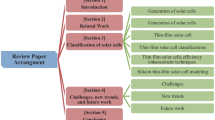Abstract
In this work, transient electroluminescence (EL) (brightness-voltage waveform curve) was utilized to investigate the working mechanism of alternating-current biased organic light-emitting diodes (AC-OLEDs). In lower frequency domain, injection potential barrier was the dominant effect to determine the luminescence intensity; with increased frequency, the influence of capacitance effect becomes dominant, which can be confirmed according to the investigations on stable EL of the AC-OLEDs. The results indicate that transient and stable EL can agree with each other perfectly. Besides, the stable EL reveals that the thinner device can take more effective capacitance effect.
Similar content being viewed by others
References
Liu C P, Wang WB, Lin CW, Lin W C, Liu C Y, Kuo C H, Lee S H, Kao W L, Yen G J, You Y W, Chang H Y, Jou J H, Shyue J J. Molecular migration behaviors in organic light-emitting diodes with different host structures. Organic Electronics, 2011, 12(2): 376–382
Chen F P, Xu B, Zhao Z J, Tian W J, Lü P. White organic lightemitting diodes based on electroplex from polyvinyl carbazole and carbazole oligomers blends. Chinese Physics B, 2010, 19(3): 037801
Huang J Z, Xu Z, Zhao S L, Zhu H N, Song D D. Study on energy transfer in organic multilayer well structure. Synthetic Metals, 2007, 157(18–20): 739–742
Huang J Z, Li S S, Feng X P, Wang P J, Zhang Z. Breakthrough of organic electroluminescence efficiency limited to 25% of that of photoluminescence in frequency domain. Asian Journal of Chemistry, 2010, 22(6): 4688–4692
Huang J Z, Li S S, Feng X P, Wang P J, Zhang Z. Study on formation cross-section of singlet and triplet exciton in organic phosphorescent and fluorescent material. Asian Journal of Chemistry, 2010, 22(6): 4697–4702
Liu D A, Teng F, Xu Z, Yang S Y, Quan S Y, He Q F, Wang Y S, Xu X R. Influence of capacitance effect on alternating-current organic light-emitting diodes. Solid State Communications, 2006, 137(7): 391–394
Liu D A, Teng F, Xu Z, Yang S Y, Qian L, He Q F, Wang Y S, Xu X R. Enhanced brightness and efficiency in organic light-emitting diodes using an inorganic material SiO2 as a buffer layer and electron-blocking layer. Journal of Luminescence, 2007, 122–123: 656–659
Cusumano P, Buttitta F, Di Cristofalo A, Calí C. Effect of driving method on the degradation of organic light emitting diodes. Synthetic Metals, 2003, 139(3): 657–661
Zou D C, Yahiro M, Tsutsui T. Spontaneous and reverse-bias induced recovery behavior in organic. Applied Physics Letters, 1998, 72(19): 2484–2486
Liu X L, Wallmann I, Boudinov H, Kjelstrup-Hansen J, Schiek M, Lützen A, Rubahn H G. AC-biased organic light-emitting fieldeffect transistors from naphthyl end-capped. Organic Electronics, 2010, 11(6): 1096–1102
Huang J Z, Li S S, Feng X P, Wang P J, Zhang Z. Confirmation on origin of primary electron in solid state cathodoluminescence. Chinese Physics B, 2010, 19(6): 067803
Zhang F J, Zhao S L, Xu Z, Huang J Z, Xu X R. Transient demonstration of exciton behaviours in solid state cathodoluminescence under different driving voltage. Chinese Physics, 2007, 16(5): 1464–1466
Huang J Z, Li S S, Feng X P, Wang P J, Zhang Z. Study on chargetransfer exciton using solid state cathodoluminescence based on MEH-PPV (Poly[2-methoxy-5-(2-ethylhexyloxy)-1,4-phenylenevinylene]). Asian Journal of Chemistry, 2010, 22(6): 4693–4696
Huang J Z, Xu Z, Zhao S L, Li Y, Zhang F J, Song L, Wang Y S, Xu X R. Organic/inorganic hetero-structures for enhanced electroluminescence. Solid State Communications, 2007, 142(7): 417–420
Huang J Z, Xu Z, Zhao S L, Li S S, Feng X P, Wang P J, Zhang Z. Study on carrier mobility measurement using electroluminescence in frequency domain and electrochemical impedance spectroscopy. Measurement, 2010, 43(3): 295–298
Author information
Authors and Affiliations
Corresponding authors
Rights and permissions
About this article
Cite this article
Huang, J., Shao, M. & Xu, X. Transient and stable electroluminescence properties of alternating-current biased organic light-emitting diodes. Front. Optoelectron. 5, 279–283 (2012). https://doi.org/10.1007/s12200-012-0265-y
Received:
Accepted:
Published:
Issue Date:
DOI: https://doi.org/10.1007/s12200-012-0265-y




